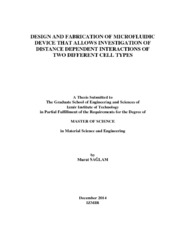Please use this identifier to cite or link to this item:
https://hdl.handle.net/11147/4282| Title: | Design and Fabrication of Microfluidic Device That Allows Investigation of Distance Dependent Interactions of Two Different Cell Types | Other Titles: | İki Farklı Hücre Çeşidinin Birbirlerine Uzaklıklarına Bağlı Etkileşimlerinin İncelenmesine İmkan Veren Mikroakışkan Cihazın Tasarımı ve Üretimi | Authors: | Sağlam, Murat | Advisors: | Pesen Okvur, Devrim Özyüzer, Lütfi |
Keywords: | Microfluidics Cells Microfluidic device Microfluidic chip Biotechnology |
Publisher: | Izmir Institute of Technology | Source: | Sağlam, M. (2014). Desingn and fabrication of microfluidic device that allows investigation of distance dependent interactions of two different cell types. Unpublished master's thesis, İzmir Institute of Technology, İzmir, Turkey | Abstract: | The main studies of in this thesis, the mold and a microfluidic device are achieved by using SU-8 photoresist and PDMS polymer. Firstly, molds are obtained which are thickness ranging from 30 to 400 μm by using SU-8 photoresist with UV lithography technique and this molding will use for shaping polydimethylsiloxane (PDMS) polymer. Finally, PDMS molds combined with the glass surface to create a three dimensional reservoirs. Microfluidic device that allows investigation of distance dependent interactions, two factors are positioned at certain distances from each other and the microfluidic device is allowed to investigation of distance dependent interaction of two factors. There is an alternating width channel between two channels which have each of two factors. These three channels are separated from each other by colonnades, not by walls, therefore physical, chemical and biological interactions are possible between the factors. Necessary physical, chemical, and biological conditioning can be provided by the reservoirs which are neighbor of channels including factors. Microfluidic chip has a lot of advantages that are small liquid volumes (pL-μL), precise spatial & temporal control, successfully mimic the physiological context, highthroughput analysis, low fabrication costs; portable and safer therefore it facilitates us to refine our methods of analysis and development in cell biology investigations and determining the content of chemical samples. | Description: | Thesis (Master)--Izmir Institute of Technology, Material Science and Engineering, Izmir, 2014 Includes bibliographical references (leaves: 43-45) Text in English; Abstract: Turkish and English xi, 45 leaves |
URI: | http://hdl.handle.net/11147/4282 |
| Appears in Collections: | Master Degree / Yüksek Lisans Tezleri |
Files in This Item:
| File | Description | Size | Format | |
|---|---|---|---|---|
| T001305.pdf | MasterThesis | 1.84 MB | Adobe PDF |  View/Open |
CORE Recommender
Page view(s)
348
checked on Apr 28, 2025
Download(s)
390
checked on Apr 28, 2025
Google ScholarTM
Check
Items in GCRIS Repository are protected by copyright, with all rights reserved, unless otherwise indicated.